|
|
|
Sort Order |
|
|
|
Items / Page
|
|
|
|
|
|
|
| Srl | Item |
| 1 |
ID:
188066
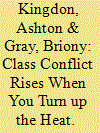

|
|
|
|
|
| Summary/Abstract |
The increasing impacts of climate change have created a global humanitarian crisis. Growing populations, unstable political structures, and competition over scarce resources are generating unprecedented levels of insecurity. Capitalising on these complex situations, terrorist organisations are using the environment as a weapon of war, exploiting the strains and grievances exacerbated by climate change to increase support, aid recruitment, and incite violence. Often neglected within contemporary analyses is the potential impact of anthropogenic climate change on left-wing terrorist organisations. Consequently, the research presented in this paper takes an interdisciplinary approach, combining terrorism studies with disaster management to examine a specific type of security crisis that exists in this overlapping relationship between climate change and left-wing conflict. Three regional case studies of terrorist groups and activity are examined in detail—the Revolutionary Armed Forces of Colombia, the Shining Path in Peru, and Naxalites in India. The article reveals the complex issues that underlie climate disasters, focusing on the impact hazards such as deforestation, rising sea levels, extreme weather, glacial retreat, drought, famine, water scarcity, and migration have on left-wing terrorist recruitment and activity.
|
|
|
|
|
|
|
|
|
|
|
|
|
|
|
|
| 2 |
ID:
154973
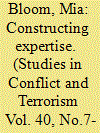

|
|
|
|
|
| Summary/Abstract |
The academic literature is divided with regard to whether terrorist recruits are dangerous masterminds, “malevolently creative,” and capable of perpetrating well-planned mass casualty attacks in the heart of European capitals. Or whether they are imbeciles, incapable of carrying out the most basic tasks, who mostly end up blowing themselves up by accident. This duality about the capabilities of terrorists is reflected in analyses of terrorist incidents. In fact, both depictions of terrorist recruits are accurate. Acuity and professionalism are not movement dependent (the same group may attract a variety of recruits) and might, instead, reflect a recruitment cycle that terrorist groups experience—one that alternates between labor-intensive and expertise-intensive periods of recruitment. The phases may shift because of external pressures (periods of territorial expansion/contraction) and opportunities (need for better quality recruits) with associated shifts in how groups use propaganda to attract a different quality of recruit during different periods of time. A possible first step toward hindering terrorist recruitment is to better understand the ways in which terrorist organizations work—where and when they recruit, whom they target, and the different propaganda messages used for selective/targeted recruitment. A clearer picture of the process could provide opportunities to counter a group's appeal, replenish their ranks, and inoculate vulnerable populations against recruitment. Case studies of three different terrorist organizations (Al Qaeda, the Islami State in Iraq and Syria [ISIS], and the Provisional Irish Republican Army [PIRA]) presented here posit that there exists a terrorism “recruitment cycle” that alternates between labor and expertise focus, uses different recruitment strategies and different propaganda messaging depending on this cycle.
|
|
|
|
|
|
|
|
|
|
|
|
|
|
|
|
| 3 |
ID:
131340
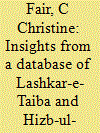

|
|
|
|
|
| Publication |
2014.
|
| Summary/Abstract |
This article uses a novel database of 1,625 posthumously published biographies of members of two Islamist militant organizations (Lashkar-e-Taiba (LeT) and Hizb-ul-Mujahideen (HM)), all of whom were killed in the course of carrying out militant attacks. In general, each biography provides data on the militant's birthplace, education, recruitment, and training. The number of observations in this database is a full order of magnitude larger than those of previous databases assembled from militant biographies. While the sample of militants in this database is the product of multiple selection effects, analysis of the database undermines many common myths about Pakistani militants and casts doubt on current policy approaches to mitigating Islamist militancy in Pakistan.
|
|
|
|
|
|
|
|
|
|
|
|
|
|
|
|
| 4 |
ID:
057595
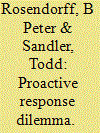

|
|
|
| 5 |
ID:
113949
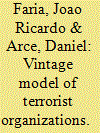

|
|
|
|
|
| Publication |
2012.
|
| Summary/Abstract |
A dynamic model of a terrorist organization is presented with the defining feature being that a succession of operatives is recruited at different points in time. Consequently, a government's counterterror policy must be tailored according to the vintage structure of the terrorist group that it faces. This implies that past history of counterterror policy and attacks matter for the formulation of current and future policy. The authors present the necessary steps to formulate and solve a vintage model, and to deal with the delay differential equations that naturally arise from the vintage structure. The resulting analysis captures the implications of a diverse set of phenomena such as Internet recruiting, training delays for logistically complex plots, age distribution of operatives, and the sensitivity of government impatience/cabinet composition to terrorist events for the inner dynamics of terrorist organizations and counterterror policy. Directions for future research are also suggested.
|
|
|
|
|
|
|
|
|
|
|
|
|
|
|
|
|
|
|
|
|